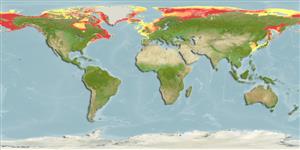Common names from other countries
Classification / Names / Names
ماع يماسا | فدارتم | Catalog of Fishes (gen., sp.) | ITIS | CoL | WoRMS
Environment: milieu / climate zone / depth range / distribution range
يسانش موب
دننک یم هیذغت و یگدنز رتم 002 ریز قامعا رد هک یتادوجوم. Temperate; 90°N - 0°S, 180°W - 180°E
Pacific Northwest, Pacific Ocean, Atlantic Ocean and the Arctic: Bering Sea, Sea of Okhotsk, Atlantic Ocean, Canada Quebec, Alaska, Greenland, Canada Newfoundland, Norway, Russia, Japan (Ref. 1394), Canada, Iceland, UK, France, Spain, Portugal, China, Kamchatka, Laptev Sea (Ref. 1522); Erignathus barbatus barbatus: Canada, Greenland, Russia, Canada Newfoundland, Iceland, Norway, UK, France, Spain, Portugal; Erignathus barbatus nauticus: Russia, Canada, Laptev Sea, Alaska, Japan, China, Sea of Okhotsk, Kamchatka.
Length at first maturity / Size / Weight / نس
Maturity: Lm ? range ? - ? cm Max length : 250 cm TL يسنج صاوخ نودب / رن سنج; (Ref. 1394)
They usually restrict themselves to sea ice and stay in relatively shallow areas of continuously moving ice, where open leads and polynyas regularly form. In some areas, they are known to haul out on shore, ascend streams, or live a pelagic existence away from ice and land for long periods of time. Feeds on many species of small invertebrates that live on, and in, the bottom; and fish (Ref. 1394). They usually restrict themselves to sea ice and stay in relatively shallow areas of continuously moving ice, where open leads and polynyas regularly form. In some areas, they are known to haul out on shore, ascend streams, or live a pelagic existence away from ice and land for long periods of time. Feeds on many species of small invertebrates that live on, and in, the bottom; fish (Ref. 1394).
یلصا ذخآم
عجارم | هدننك گنهامه | ناراكمه
Jefferson, T.A., S. Leatherwood and M.A. Webber. 1993. (Ref. 1394)
NCUI زمرق تسرهف رد تيعضو (Ref. 130435)
ستياس رظن زا تيعضو (Ref. 108899)
Not Evaluated
Not Evaluated
یناسنا هدافتسا
تاليش – يريگ يهام: يراجت
FAO - تاليش – يريگ يهام: landings, هنوگ هيامن | FishSource | Sea Around Us
اهرازبا
يتنرتنيا عبانم
Estimates based on models
Preferred temperature
(Ref.
115969): -1.7 - 8.9, mean 0.5 (based on 6792 cells).
یگدنهج
طسوتم, لاس 4/4 – 1/4 تيعمج ندش ربارب ود يارب مزال نامز هنيمك (K=0.18-0.29).
یريذپ بيسآ
Moderate to high vulnerability (55 of 100).
تميق هقبط
Unknown.
